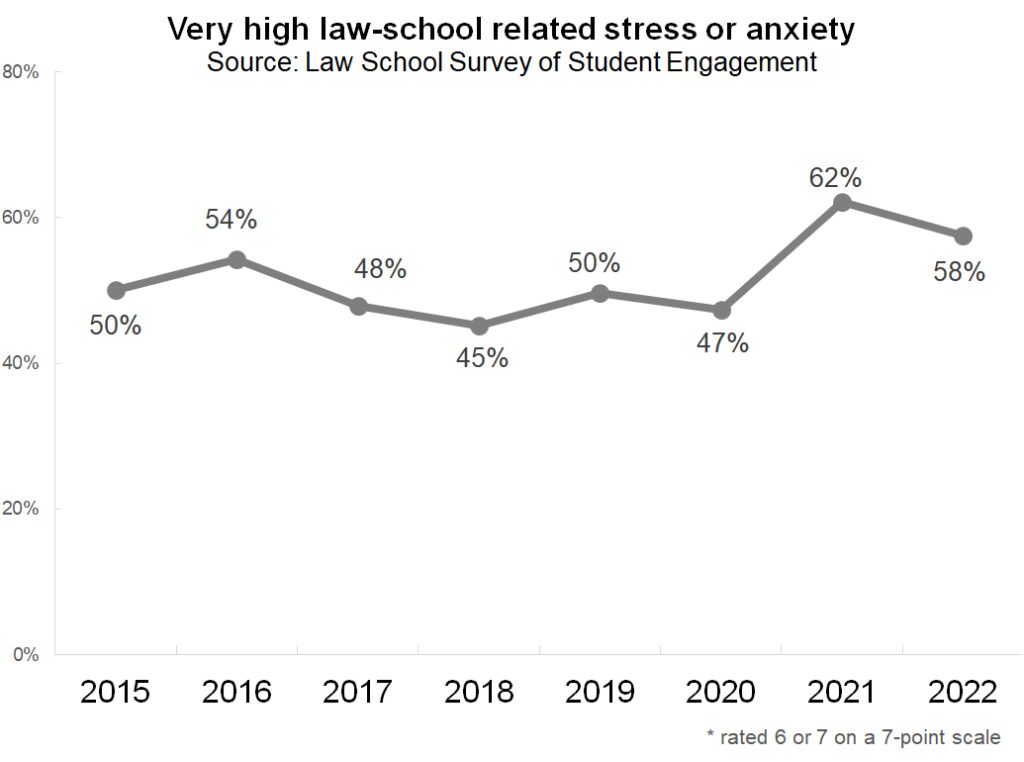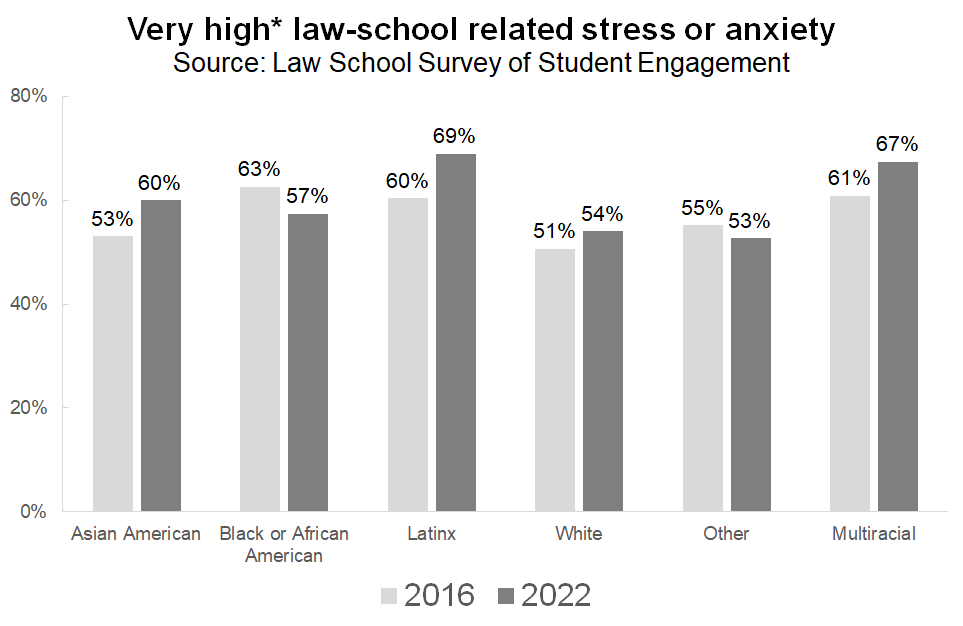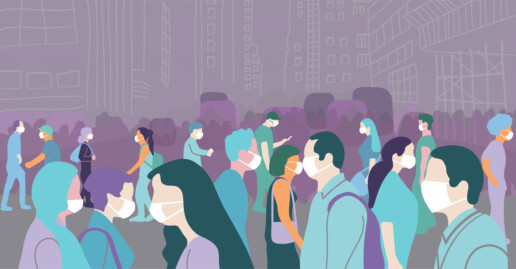Relationships with Law Faculty
Law students generally have strong relationships with law school faculty members. In 2022, 71% of LSSSE respondents ranked their relationships with faculty a 5 or higher on a 7-point scale, where 7 represents faculty who are “available, helpful, and sympathetic.” Only 12% of students ranked their relationships a 3 or lower, and a mere 1% of students ranked their relationships a 1, meaning they feel that the faculty at their law school are “unavailable, unhelpful, and unsympathetic.”
Relationships with instructors are built both inside and outside the classroom. More than half (53%) of law students discussed assignments with a faculty member often or very often, and only 5% never discussed assignments with a faculty member. After completing assignments, most law students (91%) receive prompt feedback from faculty on their academic performance at least sometimes. However, only 13% say they receive prompt feedback very often, and 9% never receive prompt feedback.
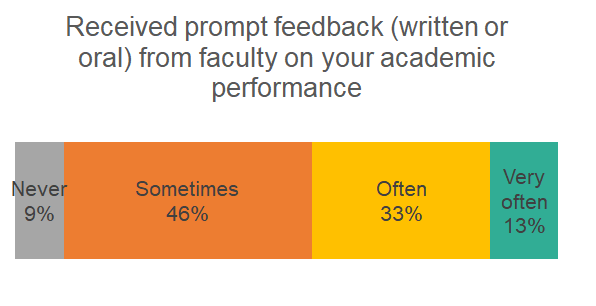
About one in five students (21%) often or very often discussed ideas from their readings or classes with faculty members outside of class, and another half (50%) did so sometimes. This practice tapers off a bit over time, with 22% of first-year students discussing ideas with faculty members outside of class often or very often compared to 19% of 3Ls and 11% of 4Ls.
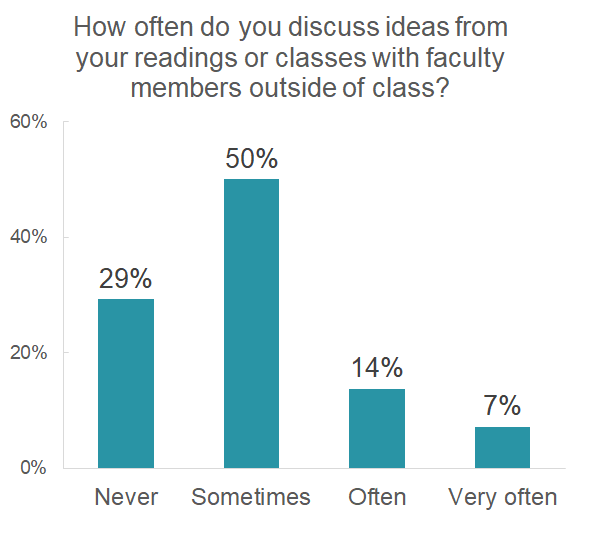
Law school faculty can provide crucial guidance about navigating the legal job market, and the vast majority of students (84%) take advantage of their advice. Just over a third of students (36%) discuss their career plans or job search activities with a faculty member of advisor often or very often. Around 82% of first-generation students (neither parent holds a bachelor’s degree) have discussed their career plans with faculty compared to 85% of their non-first-generation peers.
The relationships students form during their time in law school can be crucial to their future success. The majority of law students make the most of these relationships, and they appreciate the support and knowledge they receive from the faculty of their law schools.
New Questions Focusing on Law Students with Disabilities
By popular demand, LSSSE is now capturing information about the experience of law students with disabilities. Law students are given the opportunity to select one or more conditions using the following questions:
Have you been diagnosed with any disability or impairment?
- Yes
- No
- I prefer not to respond
Which of the following impacts your learning, working, or living activities?
- Sensory disability
- Blind or low vision
- Deaf or hard of hearing
- Physical disability
- Mobility condition that affects walking
- Mobility condition that does not affect walking
- Speech or communication disorder
- Traumatic or acquired brain injury
- Mental health or developmental disability
- Anxiety
- Attention deficit or hyperactivity disorder (ADD or ADHD)
- Autism spectrum
- Depression
- Another mental health or developmental disability (schizophrenia, eating disorder, etc.)
- Another disability or condition
- Chronic medical condition (asthma, diabetes, Crohn’s disease, etc.)
- Learning disability
- Intellectual disability
- Disability or condition not listed
- Please describe your disability or condition
In 2022, nearly one in five (19%) of LSSSE respondents had a disability. Students who responded "yes" to the disability question then had the option to select the condition(s) that impact their learning, working or living activities. Mental health conditions were by far the most common, with about 13% of law students having a condition such as anxiety, ADHD, or autism. Four percent of law students had a condition not specified on the survey such as a chronic health condition or a learning disability. Two percent of respondents had a physical disability, and one percent had a sensory disability such as being deaf or hard of hearing.
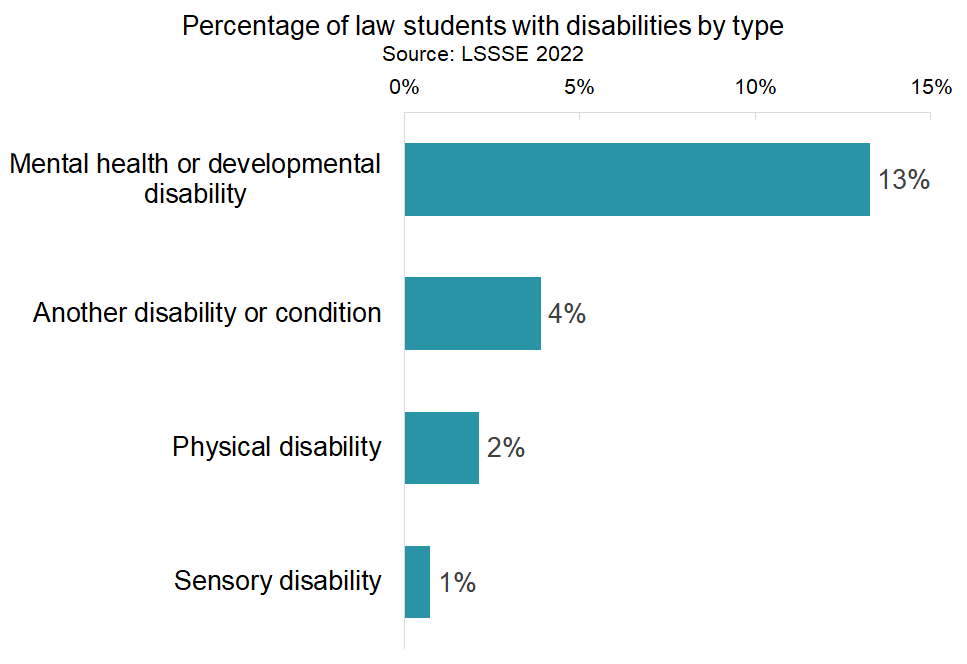
In addition to tracking the overall proportion of law students who are disabled, these new data give us an exciting opportunity to explore how students with disabilities might engage differently with their law schools and what particular experiences or services law schools can offer to better help these students succeed as professionals. For example, law students who have a disability are more likely to participate in class discussions, both online and in person, compared to their non-disabled peers. Additionally, students with disabilities are more likely to engage in pro bono work or public service during law school. Near four out of five students with disabilities (79%) either plan to or have done pro bono work or public service compared to 74% of non-disabled students.
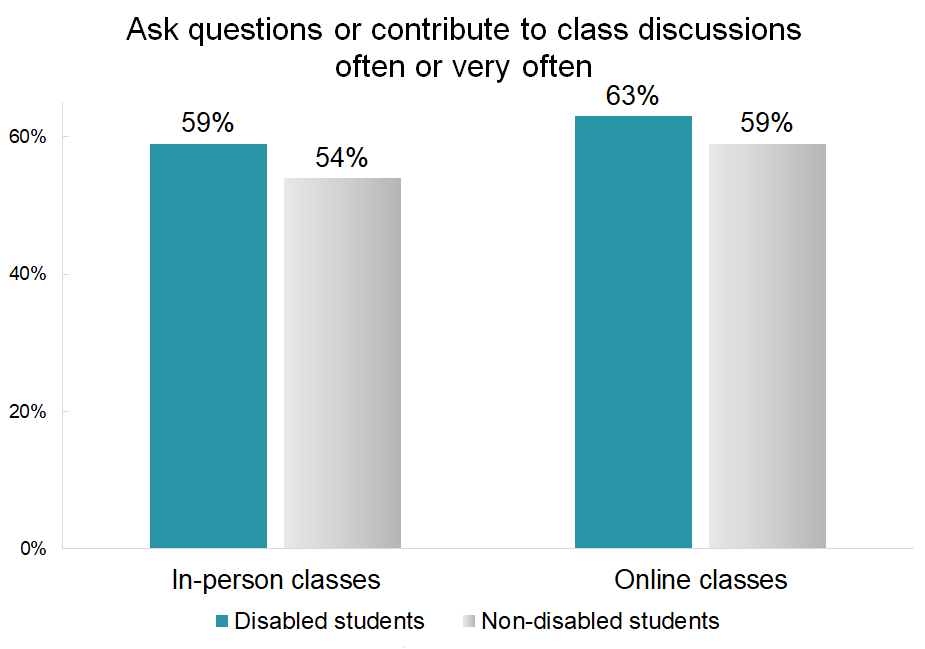
However, disabled students are less likely to be satisfied with their experiences with academic advising and career advising compared to their classmates. This suggests that law students with disabilities engage intensely with the law school experience but do not always feel as supported as their non-disabled peers.
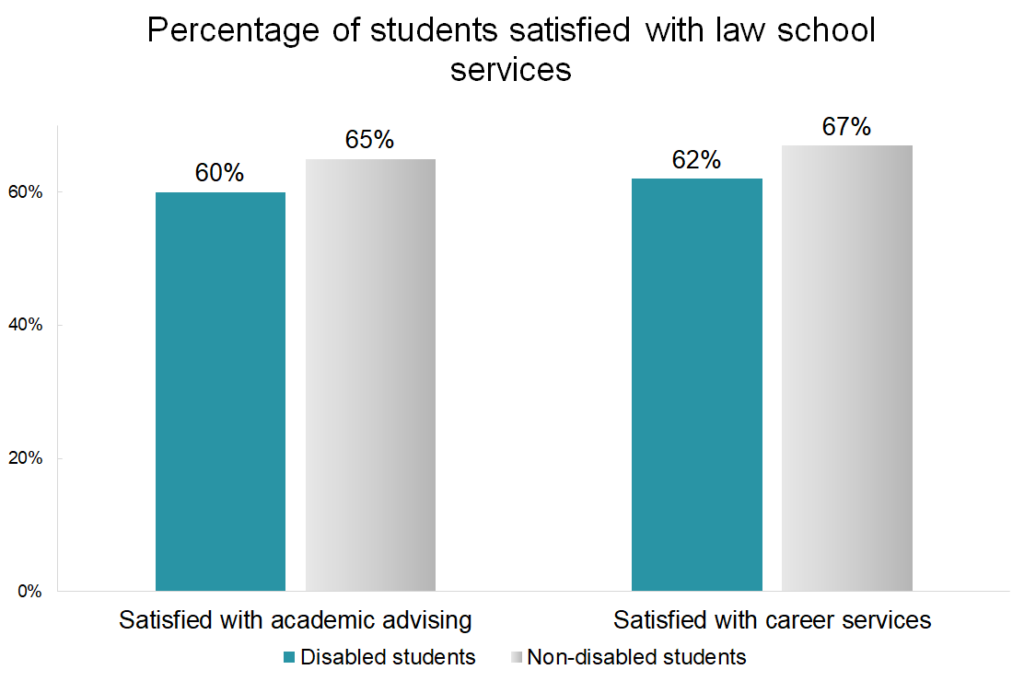
The new disability questions are included in the core LSSSE survey and available to all participating law schools. Survey registration will be opening soon; contact LSSSE for more details!
Providing the support law students need to succeed academically
A strong academic program is the foundation of any law school. Equally important is that law schools provide the support services students need to meet the rigors of the curriculum. About two-thirds of law students feel that their law school places “quite a bit” or “very much” emphasis on providing the support they need to succeed academically.
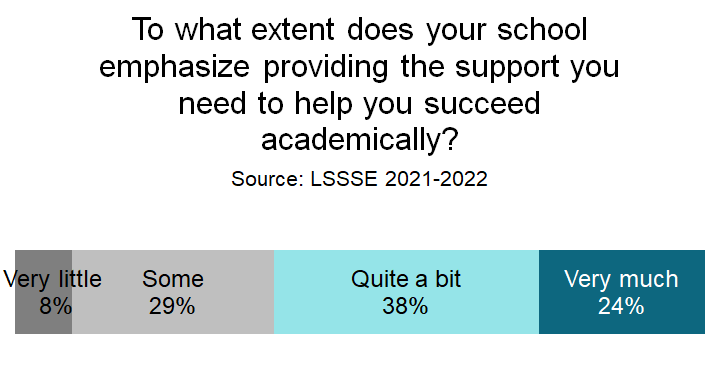
1L students are more likely to feel supported than their more advanced colleagues. Although the general optimism and positivity that 1L students feel toward their experience tends to steadily decline with advancing years for any measure of engagement, for the perception of academic support, satisfaction drops markedly among 2L students and then remains at that level during 3L and 4L years. This suggests that there is an initial sense of being supported that fades fairly quickly after students adjust to their new environment.
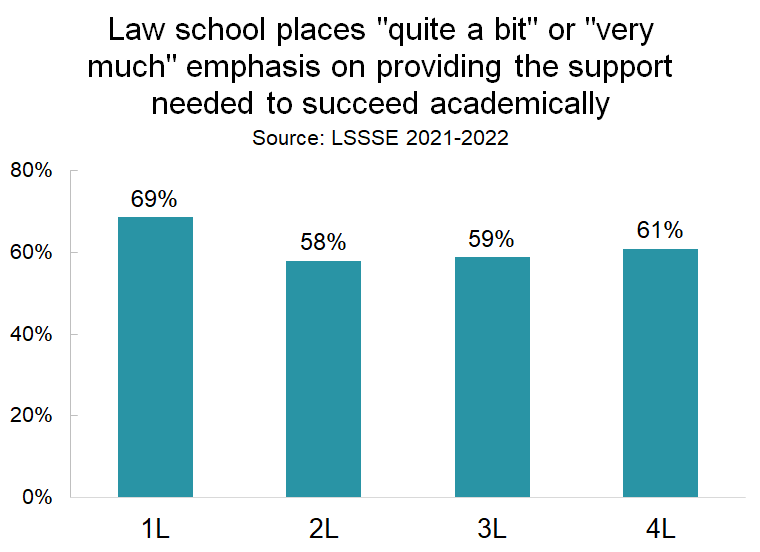
Two-thirds of men feel that their law schools places a strong emphasis on supporting academic success, which is slightly higher than the proportion of women who feel similarly (60%), but fewer than half of the people who have another gender identity feel that level of academic support.
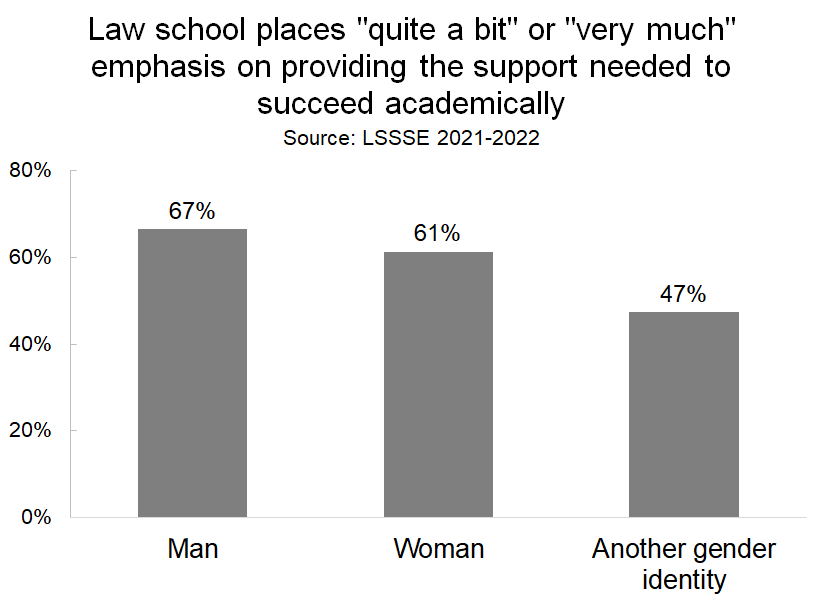
Importantly, the degree to which students feel academically supported is very strongly correlated with whether they are satisfied with their overall law school experience. A full 91% of students who rate their experience as “excellent” feel supported in their academic success compared to only 7% of students who have are having a “poor” experience.
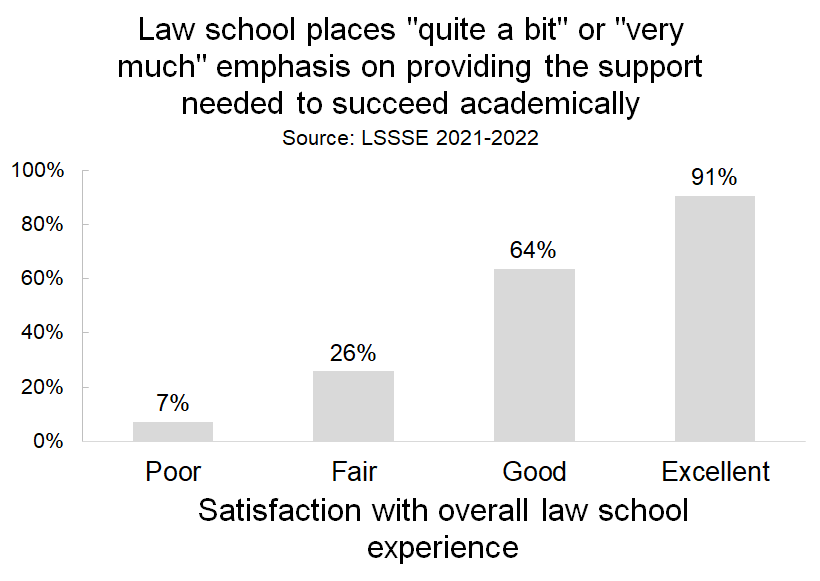
Perceived degree of academic support is also closely tied to whether a student would choose their law school again if they could start over, although the relationship is slightly less stark than for overall law school satisfaction. Among students who would either probably not or definitely not attend the same school, about 32% feel supported to succeed academically. But among students who would probably or definitely attend the same school, 70% feel academically supported.

Law students are driven to succeed in the face of the challenges presented by their academic program. Students who feel supported in their academic endeavors by their schools are more likely to be satisfied with their overall experience and to say that they would choose the same school if they could start over. Academic support is integral to a successful law school experience and likely impacts students’ long-term satisfaction and likelihood to become alumni who speak highly of their alma maters.
First Generation College Students Bear More Law School Debt
First generation law students, defined as those students who do not have at least one parent with a bachelor’s degree, face unique hurdles in higher education. In addition to navigating an unfamiliar cultural landscape, first generation students may be particularly challenged by financial concerns and student debt. In fact, although 75% of non-first generation law students expect to have some debt from attending law school, that number climbs to 88% for first generation students.
Additionally, the total dollar amount owed in student debt tends to be higher for first generation students. LSSSE 2021 and 2022 survey data show that first generation law students expected to owe an average of $96,000 compared to $71,000 for their non-first generation classmates. Around 45% of first generation students expected to owe over $100,000, but only 31% of non-first generation students expected to have loan balances that high. Shockingly, first generation students are twice as likely as their non-first generation peers to owe more than $200,000, which is the highest debt category recorded by LSSSE. Only four percent of non-first gen students fall into this category, compared to a full nine percent of first gen students.

The differing financial picture for these groups of students takes an emotional toll. Although first gen and non-first gen students report similar stress levels related to law school (about 84% rank their stress a 5 or higher on a 7-point scale), two-thirds of first gen students say that financial concerns and student debt are a big source of stress or anxiety compared to less than half (46%) of non-first gen students.

Law Student Stress and Anxiety
Are today’s law students just as stressed as yesterday’s law students? LSSSE has been tracking student stress levels for the last eight years with our optional Student Stress module. In addition to overall law school-related stress and anxiety, the module asks about anxiety and stress caused by teaching methods, competition with peers, financial concerns, and more.
The percentage of students who report high levels of stress and anxiety (rated as a 6 or a 7 on a seven-point scale) has remained fairly stable over the last several years. About half of all law students feel very high levels of stress. There was a marked increase in highly stressed students between 2020 and 2021, which is likely a byproduct of living through a year of COVID-19.
Stress about financial concerns has remained mostly stable as well. A little less than half of all students feel that financial concerns and student debt cause them “quite a bit” or “very much” stress or anxiety.
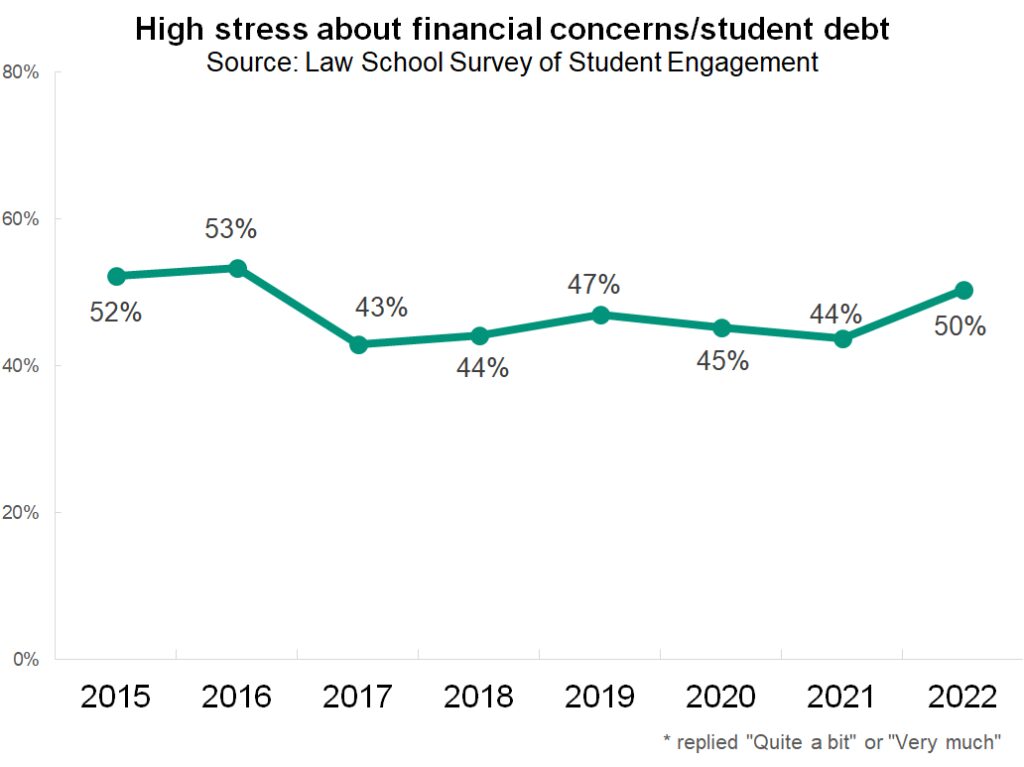
While stress levels have not changed considerably in the last several years, neither has the fact that some students are more likely to be stressed than others. Although African American and Latinx students experience only slightly higher levels of overall law school-related stress and anxiety relative to their white and Asian American peers, they are much more likely to be stressed about financial concerns. These fears are justified, given that the burden of student debt falls disproportionately on their shoulders.
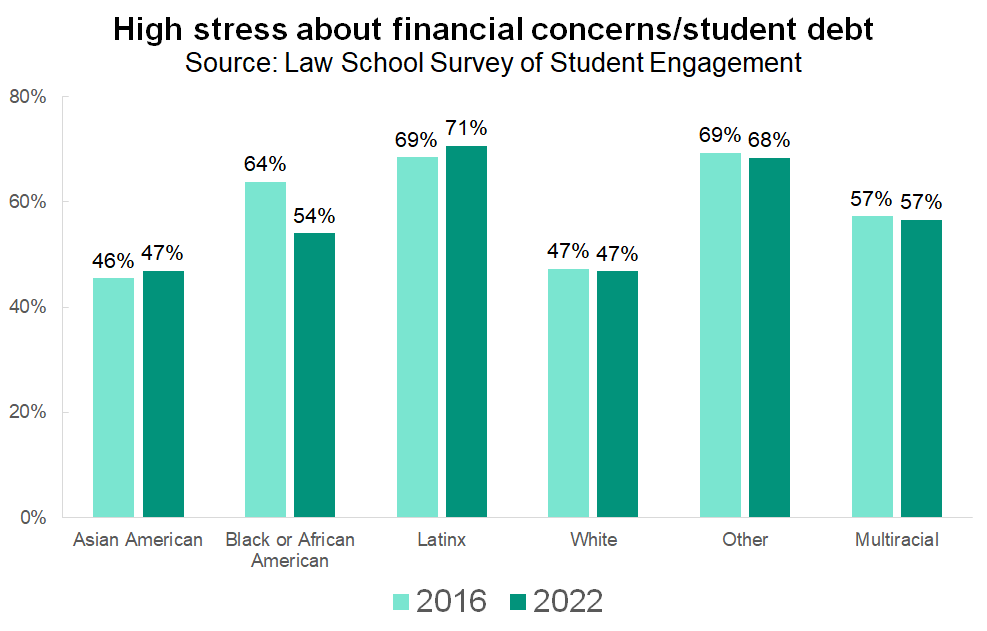
Fortunately, most students do sense that their law school tries to help with stress management. In 2022, three-quarters of student said that their law school places at least some emphasis on ways to effectively manage stress and anxiety. Given high rates of substance misuse and mental health issues within the legal community, developing strong coping skills should remain a high priority for law schools and the future lawyers they serve.
Online Learning and Law Student Age
The 2020-2021 academic year was unlike any other, forcing students and instructors to adapt to a different way of living and learning. Prior to the pandemic, law schools were less likely than other sectors of academia to embrace online learning. But when it became clear that COVID was not going away, many law schools shifted to primarily online interactions. The Online Learning module, which debuted with the spring 2021 LSSSE survey administration, was developed to capture students’ perceptions and experiences with online classes during this peculiar academic year and potentially beyond. Although the abruptness of the transition to online learning and the external stressors inherent to pandemic life may make these data unique in some ways, in other ways they are an excellent starting point for law schools to learn about how to structure their curriculum to leverage the strengths of the online environment, even as traditional in-person learning resumes.
What types of online learning experiences were law students having in 2020-2021? Nearly all students who took online courses had at least some synchronous element in their courses. Nearly two-thirds of students typically had synchronous courses while another third experienced a mixture of synchronous and asynchronous content. Only about two percent of students typically received only asynchronous content.
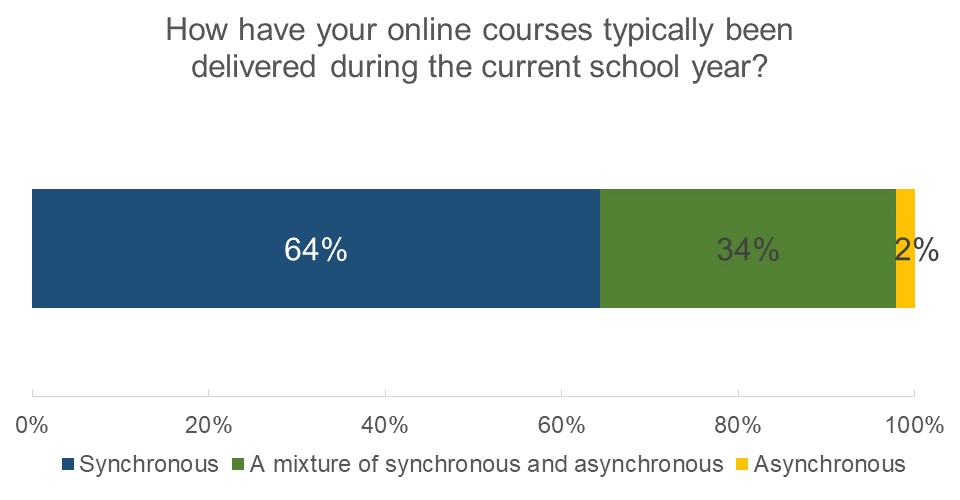
Most law students were fairly comfortable with online learning. Seventy percent of students were mostly comfortable or very comfortable interacting with the instructor of their online courses, and around 65% felt similarly about interacting with the other students. About two-thirds of students were comfortable with online discussion tools such as discussion boards and forums and about two-thirds of students were comfortable with live online course discussions.

Interestingly, older students were more likely to be comfortable with virtually all aspects of online learning relative to their younger peers. In fact, comfort with online learning tools increased steadily across age brackets. The vast majority (86%) of students over 40 were comfortable participating in live online discussions compared to only around 62% of students 25 or younger.

This age discrepancy in participation exists in physical classrooms too. In 2019, before the widespread adoption of online law classes, 80% of students over age 40 often or very often asked questions in class or contributed to class discussions, compared to 48% of those 22 or younger and 54% of those between 23 and 25. In fact, students under age 30 may be somewhat more comfortable with online course discussions than in-person ones, even though their overall participation is less than that of their older classmates regardless of the class setting.

Older students were also more likely to be comfortable interacting with their peers and instructors online. Only 63% of students age 22 or younger were comfortable interacting with their instructors online, compared to a full 85% of students over 40. Among students between the ages of 23 and 25 (the most common age for a law student), less than two-thirds were comfortable interacting with other students in their online classes, compared to a full 78% of students over 40.

Although popular media tends to suggest that younger people are more adept with technology, the oldest Millennials – the first generation to live much of their lives online – are now in their forties. Perhaps these older students have adapted to so much online technology across their personal and professional lives that another pivot was not as disruptive as it was for their younger colleagues. Regardless of the reason, the LSSSE data show clearly that law schools should make a deliberate effort to support the technological skills and online engagement levels of their youngest students.
Part 2: The COVID Crisis in Legal Education: Concern about Meeting Basic Needs
In our last post, we used LSSSE longitudinal data that was first reported in our 2021 Annuals Results, The COVID Crisis in Legal Education (pdf), to discuss the areas of law student engagement that were most impacted by the COVID-related challenges of the 2020-2021 academic year. In addition to the intangible losses, COVID also deepened ongoing disparities and inequities in legal education, as it did in society more generally. Student populations that were especially vulnerable pre-pandemic faced even greater challenges over the past year. The crisis has been perhaps most critical when considering basic necessities, though every level of Maslow’s hierarchy of needs has been affected—from the essentials of food, rest, physical safety, and financial security to the desire for belonging, appreciation, and ultimately achieving one’s full potential.
In 2021, many students struggled to meet their basic needs. In their responses to the LSSSE survey module Coping with COVID, 43% of all law students reported increased concern about having enough food due to COVID-19. This already troubling finding about students as a whole masks significant racial disparities with food insecurity: over half of all Black (55%), Latinx (57%), and Asian American (52%) students acknowledged that the past year brought increased concerns about whether they had enough food to eat.
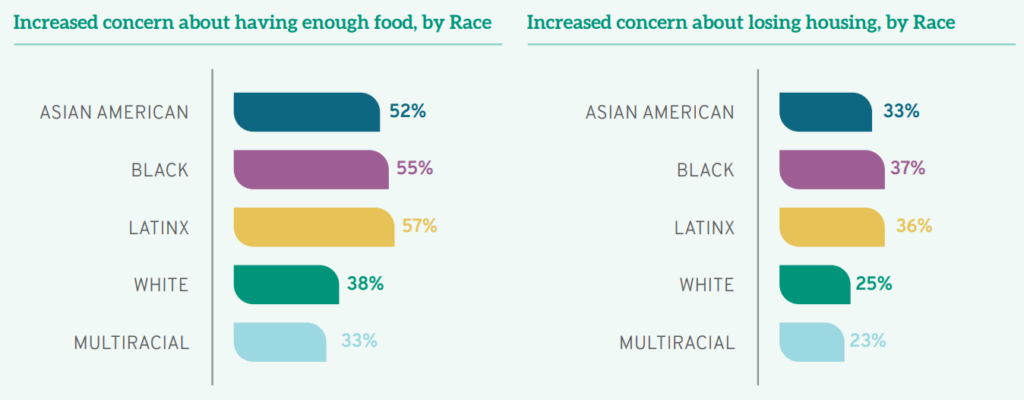
Financial concerns weighed heavily on students’ minds. Almost two-thirds (63%) of all student respondents had increased concerns about their ability to pay their bills, with both gender and race-based disparities increasing challenges for already vulnerable populations. For instance, among those who had elevated concerns about their financial security were 71% of Latinx students, 68% of Black students, 67% of multiracial students, and 64% of Asian Americans, compared to 60% of White students. Additionally, while over half of the men (57%) worried that the pandemic would affect their ability to pay their bills, over two-thirds of the women respondents (67%) faced similar financial uncertainty; a full 14% of women students reported that their financial fears had increased “very much,” compared to only 6% of men reporting that same high level of concern.
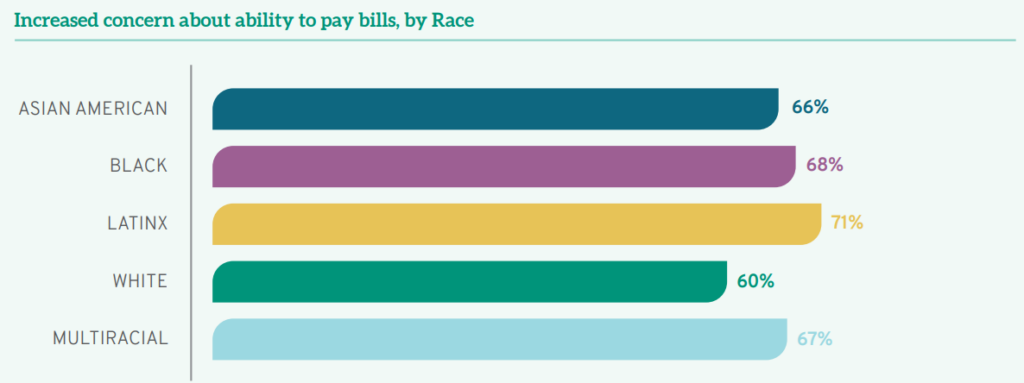
Perhaps unsurprisingly, given elevated attention to satisfying basic needs like food, shelter, and financial security, as well as the realities of the pandemic, 75% of all law student respondents also reported increased concerns about their own health and safety, while 84% were also more worried about the health and safety of friends or family. A full 75% reported a decline in their own physical health over the past year, though men fared better in this regard: two-thirds (69%) of all men surveyed noted a decline in their physical health compared to over three-quarters (78%) of women law students.

Legal education has survived what were hopefully the deepest lows of the COVID-19 pandemic. But we did not emerge unscathed. The core of legal education continued as before—the basics of teaching and learning pivoted from in-person to online, professors successfully conveyed care and concern along with doctrinal analyses, and student satisfaction levels remained remarkably high. Yet just as in other aspects of our lives this past year, legal education lost much of its depth and flavor. It has been less fulfilling, less comprehensive, less effective at imparting the intangible skills our students will need to employ in their future careers. Most critically, the Coping with COVID Report (pdf) reveals that our students have been struggling beyond anything they have experienced collectively before.
Part 1: The COVID Crisis in Legal Education: Impact on Core Mission and Enriching Experiences
Because LSSSE has been annually administered since 2004, the survey was well-positioned to capture shifts in students’ perceptions and behaviors during the uniquely challenging 2020-2021 academic year. Our 2021 Annual Results, The COVID Crisis in Legal Education (pdf) draws from the core survey and two new modules (“Coping with COVID” and “Experiences with Online Learning”) to identify key struggles and successes of legal education during a period marked by uncertainty and disruption.
In the midst of a challenging year, some positives emerge from the data. Overall satisfaction remained high throughout legal education and comparable to past years. A full 78% of students in 2021 rated their entire educational experience in law school as “good” or “excellent,” which is similar to rates from recent years (82% in 2018, and 81% in 2019 and 2020). This is a testament to the significant efforts of faculty, staff, and administrators who pivoted to meet student needs as well as to the resiliency of the students themselves.
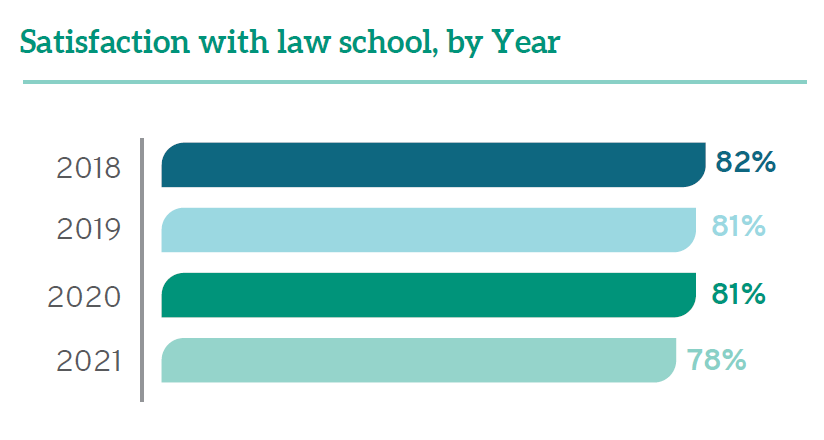
Nevertheless, the ability to forge and foster relationships has been especially difficult during the pandemic, which is borne out in the data. The percentage of students reporting positive relationships with staff dropped from 68% in 2018 to 59% in 2021—the lowest percentage recorded since LSSSE began collecting data on student-staff interactions in 2004. During those same years, positive student relationships with faculty and fellow students dropped just slightly from 76% to 72% and 76% to 73%, respectively. A full 93% of students appreciated that their law professors showed “care and concern for students” as the pandemic raged around them. First-year students were less likely to report positive relationships than 2Ls and 3Ls—likely because upper-class students could build on foundations they had cemented pre-COVID while 1Ls were attempting to start relationships from scratch in the midst of the pandemic.
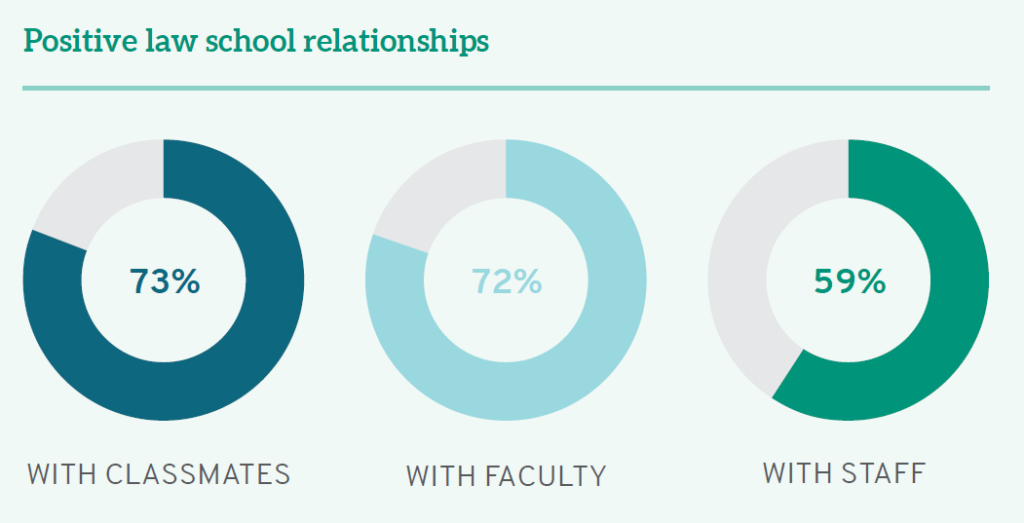
The core of legal education remains relatively unchanged. Every year from 2018 to 2021, 85% of students have acknowledged that their schools contributed “quite a bit” or “very much” to their ability to acquire a broad legal education. There were also minimal changes this year compared to years past with regard to students developing legal research skills (80- 83%) and learning effectively on their own (81-82%).
Yet the intangibles of legal education were significantly affected by COVID-19, with potential negative consequences on the professional competency of these future lawyers. A full 90% of students noted that COVID interfered with their ability to participate in special learning opportunities, including study abroad, internships, and other field placements. While discussions about course assignments and faculty feedback on academic performance remained constant, just one-third (33%) of all law students found frequent occasions to talk with faculty members or other advisors about career plans or the job search process (down from 40% in 2018), and only 19% frequently discussed ideas from readings or classes with faculty members outside of class (down from 25% in 2018). There were also fewer opportunities for students to work with faculty members on activities other than coursework.
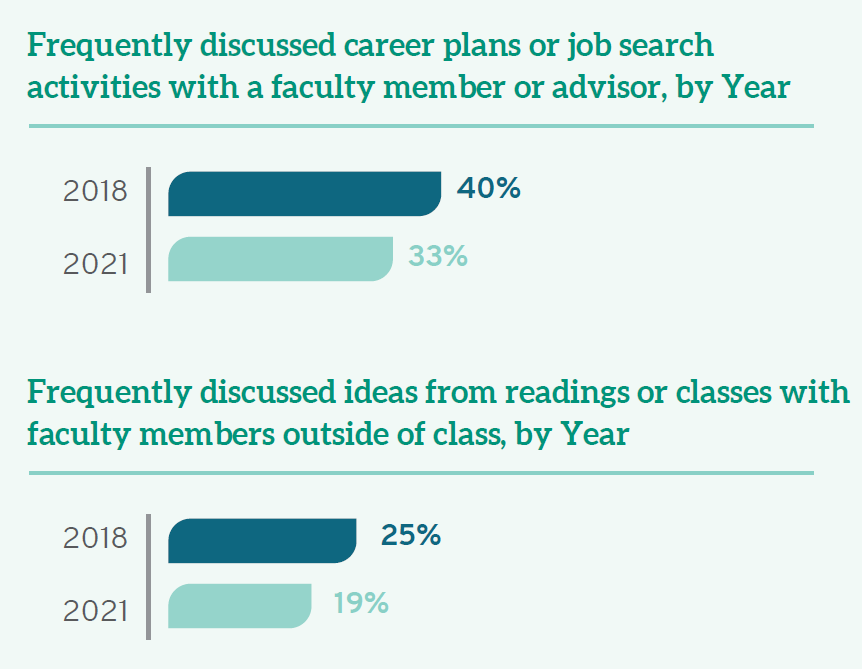
The COVID-19 pandemic has disrupted nearly all aspects of life, and law school is no exception. Although law schools did their best to continue on with the education of the next generation of lawyers, there were still marked decreases in student engagement, particularly in building relationships and gaining experience outside the classroom. In our next post, we will explore the areas in which law students struggled the most in their lives and show how the pandemic disproportionately impacted those students who were already the most vulnerable.
How Hard Do Law Students Work Outside of Class?
The average law student spends a sizeable amount of time reading and otherwise preparing for class each week. But given the stresses and time pressures placed up students, how many of them occasionally skip the required readings? We examined LSSSE data from 2004 to present to look for trends.
LSSSE’s core survey asks about how often students come to class without completing required readings or assignments. In 2021, fully 38% of students said they never came to class unprepared. This is up significantly from the all-time low in 2005 of only 27% who said they always completed required readings and assignments. In fact, there has been a steady upward trend toward meticulous class preparation over the last decade and a half.
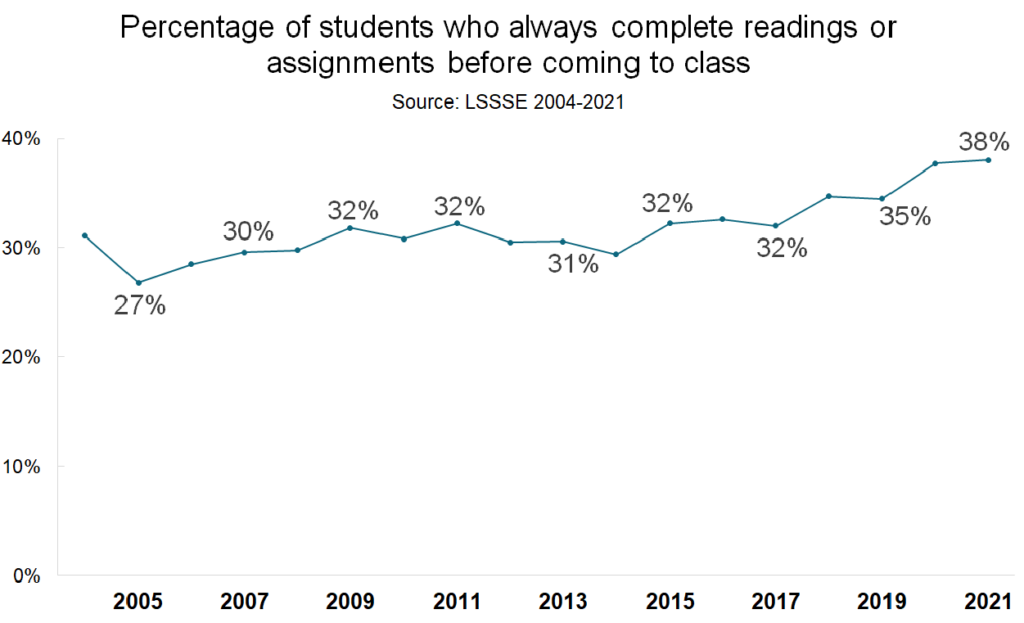
A similar attitude toward hard work outside of class time can be seen in the percentage of students who prepare multiple drafts of a paper or assignment before turning it in. In 2005, 14% of student never prepared additional drafts of their coursework. By 2019, that number had dropped to 7%. However, in 2020 and 2021, the number of students who never prepared multiple drafts increased slightly again. It will be interesting to see whether this is a pandemic-fatigue effect or whether students are gradually showing either less interest in re-writing or less available time in which to do so.
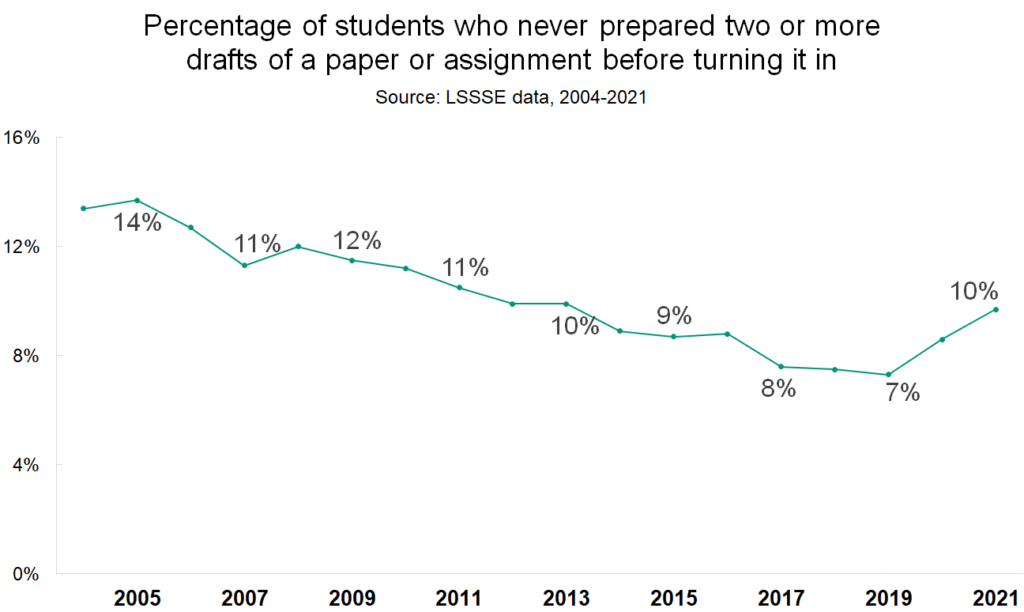
Writing can play an important role in developing critical thinking and reasoning skills, which is why it is a central component to a legal education. This is also true of doing assigned reading, which occupies about 18.5 hours of a law student’s week on average, and performing other types of course preparation, which takes another 11.2 hours of effort per week. Since LSSSE started collecting data in 2004, it appears that law students have generally become more engaged with putting in the effort necessary to reap the benefits of a legal education, even when that effort happens at home.
The Changing Landscape of Legal Education: High Levels of Satisfaction
In spite of many challenges, law students report relatively constant positive levels of satisfaction with legal education over the last decade and a half. Our 2020 special report The Changing Landscape of Legal Education: A 15-Year LSSSE Retrospective shares longitudinal findings on select metrics as well as demographic differences within variables to catalog how legal education has changed over time. In this blog post, we highlight the remarkably high levels of satisfaction that students have expressed about their law school experience since LSSSE’s inception.
When students were asked, “How would you evaluate your entire educational experience at your law school?” over eighty percent of all law students rated their experience as at least “good” with roughly one-third of all students saying they have enjoyed an “excellent” law school experience.

If we consider student satisfaction with a number of different encounters—including academic advising, career counseling, personal counseling, and job search help—we see a consistent pattern of improvement over fifteen years. While over half (53%) of students who sought out academic support were “satisfied” or “very satisfied” with advising and planning in 2004, that number grew to almost three quarters (71%) of all students by 2019. Interestingly, there are also more students using academic advising and planning today than in years past: a full 94% of students used those services last year.
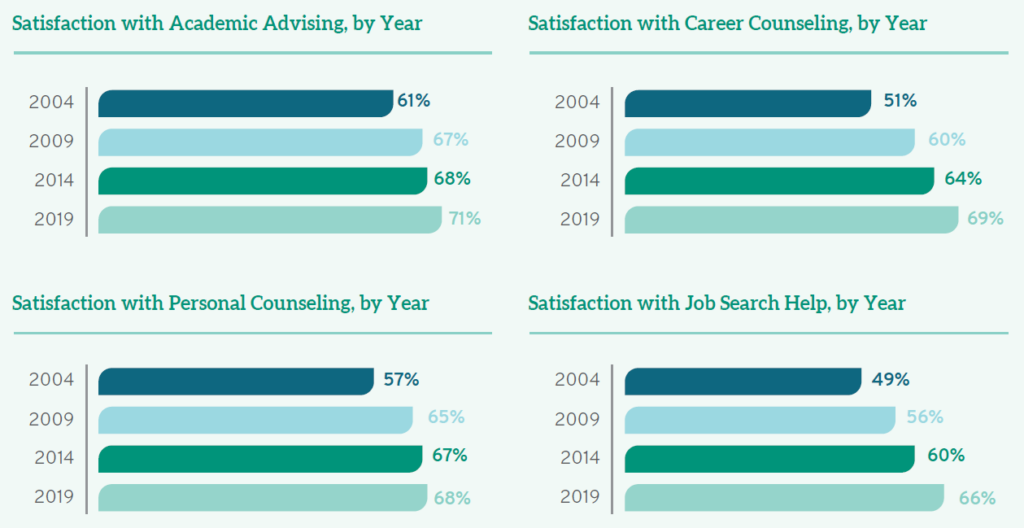
Students also appreciate how the significant investment of career counselors improves their professional prospects. While fifteen years ago, 51% of students were satisfied with career counseling (and 9.9% of these were “very satisfied), satisfaction has grown steadily over time with 60% satisfied in 2009, 64% in 2014, and a remarkable 69% satisfied in 2019 (with 22% of those noting they are “very satisfied”). As with academic advising, higher percentages of students are taking advantage of career counseling—only 8.0% of students in 2019 did not use this service (compared to 15% in 2004).
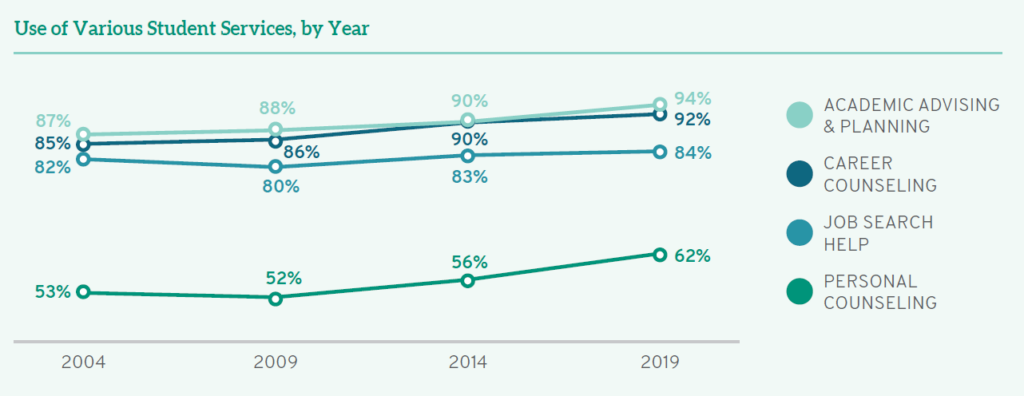
The vast majority of students sought assistance with the job search in 2004 and in subsequent years. While almost half (49%) of students were satisfied with staff efforts to provide job search help in 2004, those numbers have increased over time to 56% in 2009, 60% in 2014, and now to 66%. Although there is room for improvement, students are noticing and appreciating improvement over time.






